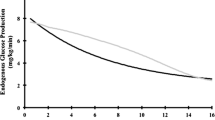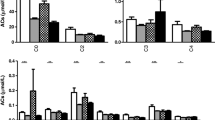Abstract
The glycogen storage disorders (GSD)-I,-III,-VI and VIII are associated with hypertriglyceridaemia or mixed hyperlipidaemia which poses the question whether these patients have an increased risk for atherosclerosis. The atherogenicity of triglycerides has remained controversial, while increased plasma cholesterol levels are generally accepted as a significant risk factor for coronary heart disease. However, clinical data show that one has to differentiate between metabolic conditions where triglycerides are atherogenic and those which are not significantly related to early onset of atherosclerosis but may cause other disorders such as pancreatitis. Among the disorders of carbohydrate metabolism patients with diabetes mellitus frequently have enhanced plasma triglycerides associated with a higher risk for coronary heart disease, while patients with certain types of glycogen storage disease have high triglyceride levels but do not seem to have an enhanced risk for atherosclerosis. Here we have compared the biochemical abnormalities and the atherogenic risk of three different disorders of glucose metabolism including GSD-I (glucose-6-phosphatase deficiency), favism (glucose-6-phosphate dehydrogenase deficiency), and diabetes mellitus which are related to either hyper- or hypolipidaemia. The available data indicate that glucose-6-phosphate (Glc-6-P) is a central molecule in cellular glucose metabolism which critically influences pentose phosphate cycle activity and, via NADPH2-generation, regulates glutathione peroxidase activity for radical detoxification and also cholesterol and triglyceride synthesis. Radical detoxification is a major protective factor for cell membrane integrity and together with an appropriate renewal of membrane lipids may protect against the development of atherosclerosis. In GSD-I, the accumulation of Glc-6-P leads to enhanced radical detoxification and thereby increases the generation of “reducing”-equivalents. In contrast in both glucose-6-phosphate dehydrogenase deficiency and diabetes mellitus there is an impaired activity of the glutathione-peroxidase system and the NADPH2-generation pentose phosphate cycle which might predispose these patients for membrane damage thus leading to haemolysis, platelet activation and atherosclerosis.
Similar content being viewed by others
Abbreviations
- GSD:
-
glycogen storage disease
- Glc-6-P:
-
glucose-6-phosphate
- HDL:
-
high density lipoproteins
- LDL:
-
low density lipoproteins
- VLDL:
-
very low density lipoproteins
- PDGF:
-
platelet derived growth factor
References
Alaupovic P, Fernandes J (1985) The serum apolipoprotein profile of patients with glucose-6-phosphatase-deficiency. Pediatr Res 19:380–384
Austin MA (1988) Epidemiologic associations between hypertriglyceridemia and coronary heart disease. Semin Thromb Hemost 14: 137–142
Block LH, Knorr W, Vogt E, Lochner R, Vetter W, Groscurth P, Quiao BY, Pometta D, James R, Regenass M, Pletscher A (1988) Low density lipoprotein causes general cellular activation with increased phosphatidylinositol turnover and lipoprotein catabolism. Proc Natl Acad Sci USA 85:885–889
Bradley WA, Hwang SC, Karlin JB, Lin AHY, Prasad SC, Gotte AM Jr, Gianturco SH (1984) Low density lipoprotein receptor binding determinants switch from apolipoprotein E to apolipoprotein B during conversion of hypertriglyceridemic very low density lipoprotein to low density lipoprotein. J Biol Chem 259:14728–14735
Brown SA, Via DP, Gotto AM Jr, Bradley WA, Gianturco SH (1986) Apolipoprotein E mediated binding of hypertriglyceridemic very low density lipoproteins to isolated low density lipoprotein receptors detected by ligand blotting. Biochem Biophys Res Commun 139:333–340
Collier A, Wilson R, Bradley H, Thomson JA, Small M (1990) Free radical activity in type 2 diabetes. Diabetic Med 7:27–30
Dessi S, Laconi E, Batetta B, Pani P (1983) Effect of 3-MC on cholesterolemia and hepatic G-6-PD. Res Commun Chem Pathol Pharmacol 41: 333–336
Dessi S, Batetta B, Laconi E, Ennas C, Pani P (1984) Hepatic cholesterol in lead nitrate induced liver hyperplasia. Chem Biol Interact 48:271–279
Dessi S, Chiodino C, Batetta B, Laconi E, Ennas C, Pani P (1986) Hepatic glucose-6-phosphate dehydrogenase, cholesterologenesis, and serum lipoproteins in liver regeneration after partial hepatectomy. Exp Mol Pathol 44:169–176
Esterbauer H, Benedetti A, Lang J, Fulceri F, Fauler G, Comporti M (1986) Studies on the mechanism of formation of 4-hydroxynonenal during microsomal lipid peroxidation. Biochem Biophys Acta 876:154–166
Fernandes J, Pikaar NA (1969) Hyperlipidemia in children with liver glycogen disease. Am J Clin Nutr 22:617–627
Forget PP, Fernandes J, Haverkamp-Begemann P (1974) Triglyceride clearing in glycogen storage disease. Pediatr Res 8:114–119
Foster DW (1989) Diabetes mellitus. In: Scriver CR, Beaudet A, Sly W, Valle D (eds) The metabolic basis of inherited disease. McGraw-Hill, New York, pp 375–397
Garnier M, Attali JR, Valensi P, Delatour-Hanss E, Gaudey F, Koutsouris D (1990) Erythrocyte deformability in diabetes and erythrocyte membrane lipid composition. Metabolism 39:794–798
Gianturco SH, Eskin SG, Navarro LT, Lahart CJ, Smith LC, Gotto jr AM (1980) Abnormal effects of hypertriacylglycerolemic very low density lipoproteins on 3-hydroxy-3-methylglutaryl-CoA reductase activity and viability of cultured bovine aortic endothelial cells. Biochem Biophys Acta 618:143:152
Gianturco SH, Bradley WA, Gotto jr AM, Morrisett JD, Peavy DL (1982) Hypertriglyceridemic very low density lipoproteins induce triglyceride synthesis and accumulation in mouse peritoneal macrophages. J Clin Invest 70:168–178
Gianturco SH, Lin AHY, Hwang SL, Young J, Brown SA, Via DP, Bradley WA (1988) Distinct murine macrophage receptor pathway for human triglyceride-rich lipoproteins. J Clin Invest 82:1633–1643
Gillery P, Monboisse JC, Maquart FX, Borel JP (1989) Does oxygen free radical increased formation explain long term complications of diabetes mellitus? Med Hypotheses 29:47–50
Hayakawa M, Kuzuya F (1990) Free radicals and diabetes mellitus. Nippon Ronen Igakkai Zasshi 27:149–54
Hers HG, Hoof F van, Barsy T de (1989) Glycogen storage disease. In: Scriver CR, Beaudet A, Sly W, Valle D (eds) The metabolic basis of inherited disease. 6th edn. McGraw-Hill, New York, pp 425–452
Hülsman WC, Eijkenboom WHM, Koster JF, Fernandes J (1970) Glucose-6-phosphatase-deficiency and hyperlipidemia. Clin Chem Acta 36:775–778
Kelley DS, Kletzien RF (1984) Ethanol modulation of the hormonal and nutritional regulation of glucose-6-phosphate dehydrogenase activity in primary cultures of rat hepatocytes. Biochem J 217:543–549
Levy E, Thibault L, Roy CC, Letarte J, Lambert M, Seidman EG (1990) Mechanisms of hypercholesterolemia in glycogen storage disease type I: defective metabolism of low density lipoproteins in cultured skin fibroblasts. Eur J Clin Invest 20: 253–260
Long WK, Wilson SW, Frenkel EP (1967) Associations between red cell glucose-6-phosphate dehydrogenase variants and vascular diseases. Am J Hum Genet 19:35–39
Luzzatto L, Mehta A (1989) Glucose-6-phosphate dehydrogenase deficiency. In: Scriver CR, Beaudet A, Sly W, Valle D (eds) The metabolic basis of inherited disease, 6th edn. McGraw-Hill, New York, pp 2237–2266
Mahley RW, Rall SC Jr (1989) Type III hyperlipoproteinemia (dysbetalipoproteinemia). The role of apolipoprotein E in normal and abnormal lipoprotein metabolism. In: Scriver CR, Beaudet A, Sly W, Valle D (eds) The metabolic basis of inherited disease, 6th edn. McGraw-Hill, New York, pp 1195–1213
Muntoni S (1989) On behalf of the ATS-Sardegna research group. Serum lipoprotein levels in G-6-PD deficient Sardinians (abstract). Xth International Symposium on drugs affecting lipid metabolism, Houston, Texas, Nov 8–11. 1989. Abstract Book, p 108
Muntoni S, Pintus F, Mascia P, Pintus P, Ganga E, Menotti A (1989) Lipidi plasmitici nella condizione di carenza di glucosio-6-fosfato deidrogenasi. Giorn Arterioscl 14:123–129
Quinn MT, Parthasarathy S, Steinberg D (1985) Endothelial cell-derived chemotactic activity for mouse peritoneal macrophages and the effect of modified forms of low density lipoprotein. Proc Natl Acad Sci USA 82:5949–5953
Rao KN (1986) Regulatory aspects of cholesterol metabolism in cells with different degrees of replication. Toxicol Pathology 14:430–437
Srivastava SK, Ansari NH, Liu S, Izban A, Das B, Szabo G, Bhatnagar A (1989) The effect of oxidants on biomembranes and cellular metabolism. Mol Cell Biochem 91:149–157
Steinberg D, Parthasarthy S, Carew TE, Khoo JC, Witzum JL (1989) Beyond cholesterol. Modification of low density lipoprotein that increases its atherogenecity. N Engl J Med 320: 915–924
Welt SI, Jackson EH, Kirkman HN, Parker JC (1979) The effects of certain drugs on the hexose monophosphate shunt of human red cells. Ann NY Acad Sci 179:625–636
Author information
Authors and Affiliations
Rights and permissions
About this article
Cite this article
Schmitz, G., Hohage, H. & Ullrich, K. Glucose-6-phosphate: A key compound in glycogenosis I and favism leading to hyper- or hypolipidaemia. Eur J Pediatr 152 (Suppl 1), 77–84 (1993). https://doi.org/10.1007/BF02072094
Issue Date:
DOI: https://doi.org/10.1007/BF02072094




